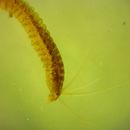Habitat
provided by Invertebrates of the Salish Sea
Fine sand
- license
- cc-by-nc-sa
- copyright
- Rosario Beach Marine Laboratory
Distribution
provided by Invertebrates of the Salish Sea
Geographical Range: SE Alaska to central California, + Yellow Sea and Japan in the western Pacific.
- license
- cc-by-nc-sa
- copyright
- Rosario Beach Marine Laboratory
Habitat
provided by Invertebrates of the Salish Sea
Depth Range: Low intertidal to 40 m.
- license
- cc-by-nc-sa
- copyright
- Rosario Beach Marine Laboratory
Comprehensive Description
provided by Invertebrates of the Salish Sea
Members of family Hesionidae have segments at least as wide as they are long, and without dorsal elytra, paleae, or other setae. They have two prostomial anteroventral palps and peristomial tentacular cirri. Enlarged ventral cirri on the first several segments is a synapomorphy for this family. Micropodarke dubia has palps with 2 segments of approximately equal length. Some of its setae are compound. It has 2 prostomial antennae and two pairs of eyes. The pharynx has no jaws nor teeth. The species has 6 pairs of tentacular cirri, 4 of which are on the peristomium. There are large lobes at the bases of the parapodia. The pygidium has two cirri. This individual is colored creamy white ventrally and has brown speckles dorsally.
- license
- cc-by-nc-sa
- copyright
- Rosario Beach Marine Laboratory
Look Alikes
provided by Invertebrates of the Salish Sea
How to Distinguish from Similar Species: Kefersteinia cirrata and Podarkeopsis brevipalpa have 8 pairs of tentacular cirri. Ophiodromus pugettensis has 3 prostomial antennae.
- license
- cc-by-nc-sa
- copyright
- Rosario Beach Marine Laboratory
Comprehensive Description
provided by Invertebrates of the Salish Sea
Biology/Natural History: I found this individual crawling through the sediment attached to the rhizome of some subtidal Zostera marina eelgrass. The family description on the Tree of Life says that the few species studied from the family seem to be predators. However, this species has no jaws nor teeth in its pharynx, and its gut was stuffed full of sediment when I found it. The sediment was gradually voided over several hours as I studied it.
- license
- cc-by-nc-sa
- copyright
- Rosario Beach Marine Laboratory
Distribution
provided by World Register of Marine Species
Micropodarke dubia is mainly in warm-temperate and tropical regions, with no current records from the whole of the Atlantic, the Pacific coast of South America, the Arctic, and the Antarctic.
Pleijel, Fredrik and Rouse, G.W. 2005. A revision of Micropodarke (Psamathini, Hesionidae, Polychaeta). Journal of Natural History 39(17): 1313-1325.
- license
- cc-by-4.0
- copyright
- WoRMS Editorial Board
Habitat
provided by World Register of Marine Species
Present from the intertidal down to 450 m, and occurs in well-sorted sand and muddy sand; it may occur in high densities on sandy beaches.
Pleijel, Fredrik and Rouse, G.W. 2005. A revision of Micropodarke (Psamathini, Hesionidae, Polychaeta). Journal of Natural History 39(17): 1313-1325.
- license
- cc-by-4.0
- copyright
- WoRMS Editorial Board

